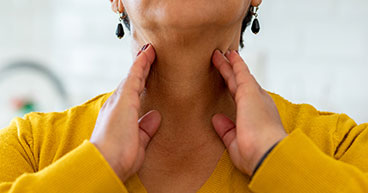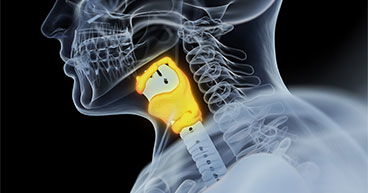
The human body is under constant attack from a number of different viruses. Some versions are harmless, causing barely a sniffle or no symptoms at all before they’re dispatched by the immune system. Other virus variants may cause severe illness or disease, such as those that cause COVID-19 or the flu.
The human papillomavirus (HPV), for instance, is a leading cause of several cancers and is quite common—infecting eight out of 10 people during their lives. Most HPV infections don’t lead to cancer, but many people don’t understand the potential cancer risk factors caused by an infection, including an increased risk for developing head and neck cancers. In fact, a 2019 survey published in the journal JAMA Pediatrics found that 70 percent of American adults don’t know about the connection between HPV and cancer.
More than 46,000 new cancer cases each year are detected in parts of the body where HPV is commonly found, and the virus is responsible for 36,000 of these diagnoses, according to the U.S. Centers for Disease Control and Prevention (CDC). The CDC also estimates 14,400, or 40 percent, of these HPV-causes cancer diagnoses, are oropharyngeal—a type of head and neck cancer.
In this article, we’ll explore the connection between HPV and throat cancers and other head and neck cancers. Topics include:
- The FYI on HPV
- Cancers linked to HPV
- HPV’s link to throat cancer
- Other risk facts for throat cancer
- What is the HPV vaccine?
- Treating HPV-related cancers
If you’ve been diagnosed with throat cancer, oral cancer or any type of head and neck cancer and want to explore your treatment options, or if you’re interested in a second opinion on your diagnosis and treatment plan, call us or chat online with a member of our team.
The FYI on HPV
HPV is the most common sexually transmitted infection in the United States, according to the CDC. HPV may be passed through skin-to-skin contact, predominately during vaginal, anal or oral sex.
HPV is a group of viruses with about 200 different variants and subvariants. Most HPV types don’t cause cancer. Some may cause warts on the surface of the skin, while others may cause them to form on the mouth, throat, vagina and anus.
HPV types are categorized in two ways:
Low-risk HPV types are generally those that may cause warts.
High-risk HPV varieties may be more likely to cause cancer.
The two main types of HPV strains associated with cancer are HPV 16 and 18, according to a 2019 review in the British Journal of Cancer.
Cancers linked to HPV
In most cases, HPV viruses are killed by the immune system before we’re aware we had them. In some cases, the virus may persist, but it’s benign and causes no symptoms.
Aggressive strains of HPV, however, may cause changes to cell structures, turning normal cells into abnormal cells. When these altered cells lose their ability to regulate their growth or shut themselves down, they may reproduce unchecked and form tumors.
Ninety-one percent of all cervical cancers are caused by HPV, according to the CDC. In recent years, experts have linked high percentages of other cancers to HPVs, and those numbers are growing. Other HPV-associated cancers include those below.
HPV-related cancers
Estimated number of new cancers diagnosed every year that are linked to HPV:
| Cancer type | Cases | HPV related | Percent |
|---|---|---|---|
| Vaginal cancer | 863 | 600 | 75% |
| Vulvar cancer | 4,191 | 2,900 | 69% |
| Anal cancer | 7,288 | 6,600 | 91% |
| Penile cancer | 1,365 | 900 | 63% |
| Throat cancer | 20,236 | 14,400 | 70% |
Source: CDC
HPV’s link to head and neck cancers
HPV may infect the area in the back of the throat, called the oropharynx, which includes the base of the tongue and the tonsils. These types of throat cancer are almost all squamous cell carcinomas and are seen more often in young adults with no history of tobacco or alcohol use.
Oropharyngeal cancers are twice as common in men than in women, and men are more often diagnosed with HPV-positive cases of the disease.
Though some people diagnosed with oropharyngeal cancer experience no symptoms, signs of oropharyngeal cancer may include:
- A long-lasting sore throat
- Earaches
- Hoarseness
- Swollen lymph nodes
- Difficulty swallowing
- Unexplained weight loss
Other risk factors for throat cancer
Smoking tobacco and consuming alcohol may increase the risk of developing oropharyngeal cancer. Avoiding tobacco products and limiting alcohol consumption is essential to reducing your risk of these cancers.
Given HPV is most commonly transmitted through sexual activity, safe sex practices, such as using condoms, may lower the chance of transmission. Above all, you should know your risk factors for HPV and take action to reduce your own risk or take steps, including vaccination, to reduce your children’s chances of contracting the virus.
Other risk factors for throat cancer include:
Use of vaping products: Most physicians discourage vaping, although more studies are needed.
Gender: Men are two to three times more likely than women to develop head and neck cancer.
Gastroesophageal reflux disease (GERD): Chronic acid reflux, or GERD, may increase the risk of throat cancer risk, depending on its frequency and severity.
Age: Head and neck cancer is more common in people over the age of 50.
Nutrition: Poor nutrition and vitamin deficiencies may raise the risk of developing the disease.
What is the HPV vaccine?
It’s almost inconceivable that we have a vaccine that can prevent high percentages of many cancers, and yet many Americans are either not aware of it or choose not to get the vaccine for themselves or their children.
In 2020, about 58 percent of American adolescents were fully vaccinated for HPV, according to the CDC. About 75 percent have received one dose.
The HPV vaccine is up to 99 percent effective at preventing HPV infections that cause cancer, according to American College of Obstetrics and Gynecology. They’re also effective at preventing the types of HPV that may cause genital warts. The vaccines work by stimulating the immune system to produce antibodies that ward off HPV infections.
The vaccine is routinely offered to boys and girls at age 11 or 12, but it’s safe for children as young as age 9 and approved through age 45.
For children and teenagers 15 and younger, the CDC recommends two doses of the HPV vaccine six to 12 months apart.
For teenagers and adults ages 15-26, the CDC recommends three doses—the second dose one to two months after the first dose, and the third dose six months after the first dose.
Young adults and pregnant women should talk to their doctor about whether the vaccine is appropriate for them.
The most common side effects or reactions to HPV vaccines include:
- Dizziness
- Nausea
- Headache
- Fever
- Pain, swelling and redness at the injection site
- Allergic reactions
Treating HPV-related throat cancer
While prevention is always better than treatment, the American Cancer Society reports that oropharyngeal cancers linked to HPV tend to have a better prognosis than those not caused by HPV.
Treatment options for HPV-related throat cancers include:
- Radiation therapy
- Surgery
- Chemotherapy
- Chemoradiation
- Targeted therapy
- Immunotherapy
- Clinical trials
Generally, chemotherapy and radiation therapy work well in these cases, but this improvement is less common in HPV-related oropharyngeal cancer patients who smoke.
If you’ve been diagnosed with throat cancer, oral cancer or any type of head and neck cancer and want to explore your treatment options, or if you’re interested in a second opinion on your diagnosis and treatment plan, call us or chat online with a member of our team.


